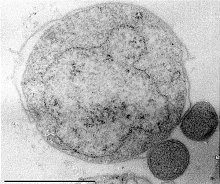Nanoarchaeota
Nanoarchaeota are a unique phylum of the Archaea, a domain of life distinct from Bacteria and Eukaryotes. First discovered in 2002, Nanoarchaeota are characterized by their extremely small size and parasitic or symbiotic lifestyle, primarily associated with other archaeal hosts. This phylum includes the notable species Nanoarchaeum equitans, which was the first to be identified and remains the most studied within this group.
Characteristics[edit | edit source]
Nanoarchaeota are ultramicroscopic in size, typically less than 500 nanometers in diameter. They possess a simplified genome, which is significantly reduced in size compared to other archaea, suggesting a high level of specialization and dependency on their host organisms for survival. Their cellular structure lacks typical features found in other archaeal cells, such as cell walls, which is indicative of their parasitic lifestyle.
The relationship between Nanoarchaeota and their hosts is not fully understood, but it is believed to range from parasitic to mutualistic. Nanoarchaeum equitans, for example, has been observed to attach to the surface of its host, the hyperthermophilic archaeon Ignicoccus hospitalis, from which it is thought to derive essential nutrients and other molecules necessary for its survival.
Habitat[edit | edit source]
Nanoarchaeota are primarily found in extreme environments, such as hydrothermal vents and hot springs, where their archaeal hosts thrive. These extreme habitats contribute to the unique physiological and biochemical adaptations observed in Nanoarchaeota, allowing them to survive under conditions of high temperature and pressure.
Genomics[edit | edit source]
The genome of Nanoarchaeum equitans was one of the first among Nanoarchaeota to be sequenced. It revealed a highly compact genetic structure, with minimal non-coding DNA and a reduced number of genes necessary for independent living. This genomic simplicity supports the hypothesis that Nanoarchaeota are highly specialized organisms with a significant dependence on their host for survival.
Evolution[edit | edit source]
The evolutionary origins of Nanoarchaeota remain a subject of scientific debate. Phylogenetic analyses suggest that they represent a deeply branching lineage within the Archaea, possibly indicating an ancient divergence from other archaeal groups. However, the extent of their genetic reduction and specialization suggests that Nanoarchaeota may have evolved through a process of reductive evolution, in which organisms lose genetic material and complexity as they adapt to a parasitic or symbiotic lifestyle.
Research and Significance[edit | edit source]
Research into Nanoarchaeota and their interactions with host organisms provides valuable insights into the complexity of microbial life and the evolutionary processes that shape it. Understanding the mechanisms of their parasitic and symbiotic relationships may also have implications for biotechnology and the development of novel microbial-based applications.
Search WikiMD
Ad.Tired of being Overweight? Try W8MD's physician weight loss program.
Semaglutide (Ozempic / Wegovy and Tirzepatide (Mounjaro / Zepbound) available.
Advertise on WikiMD
|
WikiMD's Wellness Encyclopedia |
| Let Food Be Thy Medicine Medicine Thy Food - Hippocrates |
Translate this page: - East Asian
中文,
日本,
한국어,
South Asian
हिन्दी,
தமிழ்,
తెలుగు,
Urdu,
ಕನ್ನಡ,
Southeast Asian
Indonesian,
Vietnamese,
Thai,
မြန်မာဘာသာ,
বাংলা
European
español,
Deutsch,
français,
Greek,
português do Brasil,
polski,
română,
русский,
Nederlands,
norsk,
svenska,
suomi,
Italian
Middle Eastern & African
عربى,
Turkish,
Persian,
Hebrew,
Afrikaans,
isiZulu,
Kiswahili,
Other
Bulgarian,
Hungarian,
Czech,
Swedish,
മലയാളം,
मराठी,
ਪੰਜਾਬੀ,
ગુજરાતી,
Portuguese,
Ukrainian
Medical Disclaimer: WikiMD is not a substitute for professional medical advice. The information on WikiMD is provided as an information resource only, may be incorrect, outdated or misleading, and is not to be used or relied on for any diagnostic or treatment purposes. Please consult your health care provider before making any healthcare decisions or for guidance about a specific medical condition. WikiMD expressly disclaims responsibility, and shall have no liability, for any damages, loss, injury, or liability whatsoever suffered as a result of your reliance on the information contained in this site. By visiting this site you agree to the foregoing terms and conditions, which may from time to time be changed or supplemented by WikiMD. If you do not agree to the foregoing terms and conditions, you should not enter or use this site. See full disclaimer.
Credits:Most images are courtesy of Wikimedia commons, and templates, categories Wikipedia, licensed under CC BY SA or similar.
Contributors: Prab R. Tumpati, MD

